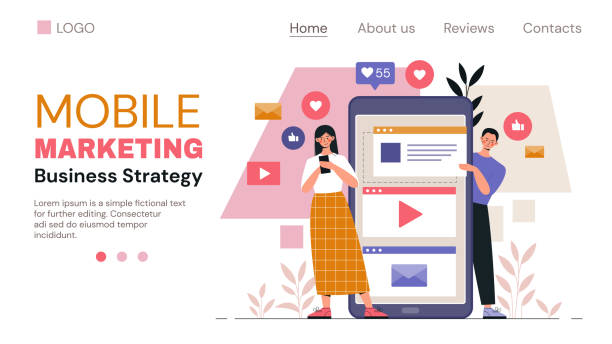Introduction to Responsive Website Design: Why Do We Need It?

In today’s world, where #users access #websites from a wide range of devices, from small smartphones to tablets and large desktops, #responsive website design is no longer a luxury option, but an undeniable necessity.
This approach in web design allows websites to automatically and intelligently adapt their layout and content to the screen size and features of the user’s device.
The main goal of responsive website design is to provide a seamless and optimal user experience for all users, regardless of the device they are using.
Before the emergence of this concept, developers had to create separate versions for mobile and desktop, which led to increased costs, maintenance complexity, and content inconsistency.
Given the significant increase in mobile internet usage, not having a responsive site means losing a huge portion of your audience and business opportunities.
A website that is properly designed responsively not only looks good on any device but is also functionally optimized and offers suitable loading speed.
This is not only beneficial for users but also crucial for SEO and search engine rankings.
In fact, Google has clearly stated that it prefers mobile-friendly and responsive websites in its rankings, which is a decisive reason for the importance of responsive website design.
Does your current corporate website not reflect your brand’s credibility and power as it should? RasaWeb solves this challenge for you with professional corporate website design.
✅ Increased visitor credibility and trust
✅ Targeted acquisition of more customers
⚡ Click for a free consultation!
Principles and Fundamentals of Responsive Design

To achieve a successful responsive website design, there are three main pillars: Fluid Grids, Flexible Images, and Media Queries.
Fluid Grids use relative units such as percentages instead of fixed pixels to define the width of columns and elements.
This approach allows the layout to fluidly and smoothly adapt to the screen size.
For example, a column that occupies 50% of the screen width on a desktop will maintain the same proportion on a smaller mobile screen.
Flexible Images, using CSS and properties like max-width: 100%;, ensure that images never overflow their container and adjust their size to fit the available space without compromising visual quality.
But the key element and mastermind in responsive design are Media Queries.
This CSS3 capability allows developers to apply rules based on device characteristics such as screen width, height, orientation (horizontal or vertical), and even resolution.
For example, it can be specified that if the screen width is less than 768 pixels (typical for tablets), the navigation menu should appear as a hamburger button instead of a horizontal bar.
This capability gives designers precise control over how elements are displayed on different devices and forms the core of any responsive website design.
A deep understanding of these principles is vital for anyone who intends to work in web design and create websites suitable for today’s needs.
These principles not only contribute to visual appeal but also maintain efficiency and user experience at the highest possible level.
Implementation Techniques for Responsive Design

Implementing responsive website design involves choosing specific strategies and utilizing appropriate tools.
There are two main approaches in this area: “Mobile-First” and “Desktop-First”.
In the Mobile-First approach, design and coding are first done for the smallest screens (mobile), and then CSS rules for larger screens (tablet and desktop) are added using Media Queries.
This method is considered more optimal because it ensures that the site loads quickly and lightly on mobile devices, which often have more limited bandwidth.
In contrast, the Desktop-First approach initially focuses on design for desktops and then adjusts the layout for smaller devices using Media Queries.
Although still used, it often results in heavier and less optimized code for mobile.
Defining Breakpoints is also one of the most important steps in implementing responsive design.
Breakpoints are specific screen widths at which the site’s layout changes to adapt to the new screen size.
These points are usually determined based on standard device sizes (such as 768px for tablets or 992px for small desktops) or based on content needs.
Additionally, correctly setting the “Viewport Meta Tag” in the <head> section of every HTML page is essential to ensure proper page scaling on mobile devices.
This tag tells the browser how to manage the page width and allows the device to match the viewport width to the device width.
Using scalable fonts and optimized images also helps improve overall site performance.
A good responsive website design not only looks beautiful but is also technically robust and optimized.
| Device Type/Resolution | Approximate Width (Pixels) | Common Use |
|---|---|---|
| Small Mobile | Below 320px | Older phones, smartwatches |
| Mobile (Portrait) | 320px – 480px | Most smartphones |
| Mobile (Landscape) / Small Tablet | 481px – 767px | Phones in horizontal mode, small tablets |
| Tablet | 768px – 991px | Most tablets |
| Small Desktop / Laptop | 992px – 1199px | Laptops, small monitors |
| Large Desktop | 1200px and above | Wide monitors, large desktops |
Impact of Responsive Design on User Experience (UX)

One of the most important reasons that responsive website design has become an industry standard is its profound impact on user experience (UX).
A website that is properly designed responsively provides a seamless and enjoyable visual and functional experience for the user, regardless of screen size.
This means there is no longer a need for annoying zooming or horizontal scrolling on mobile devices; content is automatically arranged, and navigation is easily accessible.
This ease of use not only increases user satisfaction but also reduces the Bounce Rate and increases their engagement with the site.
When users have a smooth and unimpeded experience on your site, they are more likely to spend more time on it, view more pages, and ultimately become a loyal customer or follower.
Responsive website design also helps #improve accessibility, as content becomes usable and viewable for individuals with special needs and those using assistive technologies.
A responsive web design not only impacts visual comfort but also directly affects page loading speed, especially on mobile devices.
By optimizing images and elements for each screen size, loading time is reduced, which is a crucial factor in retaining users, as studies have shown that today’s users have little tolerance for slow sites.
Therefore, investing in responsive website design is an investment in user satisfaction and the long-term success of your business.
Are you dissatisfied with the low conversion rate of visitors to customers on your e-commerce site?
Solve this problem forever with professional e-commerce website design by RasaWeb!
✅ Significant sales increase with targeted design
✅ Flawless user experience for your customers
⚡ Get a free consultation!
Responsive Design and Search Engine Optimization (SEO)

The connection between responsive website design and Search Engine Optimization (SEO) is very deep and crucial.
Since 2015, Google has explicitly stated that it prefers mobile-friendly websites in its search results rankings.
With the introduction of Mobile-First Indexing, Google primarily considers the mobile version of your website for ranking and content indexing.
This means that if your site is not responsive or provides a poor mobile user experience, your ranking in search results will be severely damaged, even if your desktop content is excellent.
One of the main advantages of responsive website design for SEO is having only one URL for each page.
This prevents duplicate content issues, which can harm SEO.
In the past, non-responsive websites often had two versions (one for desktop and one for mobile with an “m.” prefix
or subdomain), which not only complicated the management of links and redirects but also split SEO signals between two URLs.
With a responsive site, all backlinks and domain authority point to a single URL, consolidating your SEO power.
Furthermore, a reduced bounce rate and increased user dwell time on the site (which are results of a good user experience on a responsive site) also send positive signals to search engines, indicating the high quality and relevance of your content.
In summary, a responsive web design not only satisfies users but also significantly helps improve your ranking in search results.
Challenges and Solutions of Responsive Design

Although responsive website design offers countless advantages, its implementation is not without challenges.
One of the biggest challenges is Page Load Speed.
A responsive site might have to load resources (images, CSS, JavaScript) for the largest screen, even if the user is on a small device, which can lead to slow loading and high data consumption.
The solution to this problem is to use techniques such as “Responsive Images” with the <picture> tag or the srcset attribute to provide images with appropriate resolution for each device, and also “Lazy Loading” to load resources only when needed.
Another challenge is managing complex content and layouts across different screen sizes.
Some layouts or content that look great on desktop might be difficult to use or messy on mobile.
This is where the need for a precise #content strategy and “Mobile-First” design becomes important.
Developers should think from the beginning about how content will be displayed logically and user-friendly on the smallest screens and then enhance it for larger screens.
Also, testing the site across a large number of devices and browsers is an operational challenge.
Using browser simulation tools and actual tests on physical devices is essential to ensure the correct functioning of responsive web design.
With careful planning, the use of appropriate tools, and a Mobile-First approach, most of these challenges can be overcome to create an efficient and effective responsive website design.
Tools and Frameworks Aiding Responsive Design

To simplify the responsive website design process and increase development efficiency, numerous tools and frameworks are available.
These tools help developers create responsive and optimized websites without needing to write all the code from scratch.
One of the most popular frameworks is Bootstrap.
Bootstrap is a comprehensive HTML, CSS, and JavaScript framework that includes pre-built UI components, a robust grid system, and a set of utility classes for quickly building responsive layouts.
Using Bootstrap can significantly reduce coding time.
Another framework worth exploring is Foundation, which, like Bootstrap, provides a set of tools and components for building responsive websites and web applications.
In addition to complete frameworks, new CSS features like CSS Grid and Flexbox also play a significant role in facilitating responsive design.
Flexbox (Flex Container) is ideal for distributing space in one dimension (row or column), and Grid (Grid Container) for designing two-dimensional layouts (rows and columns), offering exceptional flexibility in controlling the position and size of elements across different screens.
These tools, along with CSS preprocessors like Sass and Less that allow the use of variables and functions in CSS, help developers write cleaner, more maintainable, and scalable code for responsive website design.
| Tool/Framework | Type | Advantages | Potential Disadvantages |
|---|---|---|---|
| Bootstrap | CSS/JS Framework | Comprehensive, strong documentation, large community, ready-made components | Relatively large size, similar designs |
| Foundation | CSS/JS Framework | High flexibility, lighter than Bootstrap (specific versions) | Smaller user community compared to Bootstrap |
| CSS Grid | CSS Module | Full control over two-dimensional layouts, powerful for complex arrangements | May not be supported in older browsers, learning curve |
| Flexbox | CSS Module | Excellent for distributing space in one dimension, aligning elements | Not sufficient for complex two-dimensional layouts |
| Sass/Less | CSS Preprocessors | Variables, functions, nesting, easier code maintenance | Requires compilation, adds a step to the development process |
The Future of Responsive Website Design: Beyond Mobile

The concept of responsive website design, which initially emerged to solve the problem of displaying websites on mobile phones, is now moving beyond just mobile and desktop.
With the emergence of wearables, smart TVs, car displays, and even virtual and augmented reality displays, the challenge of web design for more diverse and complex environments has gained greater importance.
The future of web design is moving towards “Adaptive Design,” where the website not only reacts to the screen size but also provides optimized content based on the user’s context, such as geographical location, internet connection speed, and even user preferences.
One of the significant trends in this area is the development of Progressive Web Apps (PWAs).
PWAs offer an experience similar to native applications through a web browser and can have capabilities such as offline access, push notifications, and being added to the device’s home screen.
This technology gives responsive website design another dimension, moving it beyond merely reacting to screen size to reacting to device capabilities and overall user experience.
Furthermore, with continuous advancements in CSS and JavaScript, tools like Container Queries (which react to containers as opposed to Media Queries that react to the Viewport) and new features that provide more capabilities for layout control in more complex scenarios are being developed.
These advancements show that responsive website design is still evolving and never reaches an endpoint, but always adapts itself to new needs and technologies.
Are you dissatisfied with the low conversion rate of visitors to customers on your e-commerce site?
Solve this problem forever with professional e-commerce website design by RasaWeb!
✅ Increase visitor-to-customer conversion rate
✅ Create an excellent user experience and build customer trust
⚡ Get a free consultation
Important Tips for Maintaining and Updating a Responsive Website

Creating a responsive website design is only half the battle; continuous maintenance and updates are crucial to ensure proper functionality and provide the best user experience in the long term.
The first step is #regular site testing on various devices and screen sizes.
Given the continuous release of new devices and browser updates, what looks great today might encounter issues tomorrow.
Using automated testing tools, as well as manual testing on physical devices, can help quickly identify and resolve problems.
Site performance is also a key factor.
Even if your site looks beautiful on all devices, if it loads slowly, you will lose users.
Continuous optimization of images, reduction of CSS and JavaScript file sizes, and the use of Content Delivery Networks (CDNs) can help improve loading speed.
Furthermore, with changes in site content, it is necessary to keep your #content strategy aligned with responsive website design.
Ensure that new content is displayed well across all screen sizes and maintains its readability.
Monitoring site traffic through tools like Google Analytics can provide valuable insights into how users interact with the site on different devices, helping you identify weaknesses and implement necessary improvements.
Finally, educating the development and content creation team about the principles of responsive design and its importance is essential for maintaining site quality and continuous updates.
Why Is Investing in Responsive Website Design a Necessity?

In today’s digital business world, investing in responsive website design is no longer a competitive advantage, but a necessity.
This approach ensures that your business is always accessible to a wide audience, regardless of the device they use to access your content.
Given the growing statistics of mobile internet browsing and online purchases, ignoring responsive web design means missing out on countless opportunities for growth and revenue generation.
A non-responsive site not only creates an unpleasant user experience, leading to an increased bounce rate and reduced conversion rate, but also damages your brand’s credibility and image in the minds of customers.
Furthermore, responsive website design, due to the SEO benefits mentioned earlier, helps you achieve higher rankings in search engines.
A higher ranking means more visibility, more organic traffic, and ultimately more customers.
Managing a responsive site is also significantly simpler and more cost-effective than maintaining multiple separate versions of the website for different devices.
This reduction in management and update complexity frees up the company’s financial and time resources to focus on other aspects of the business.
Finally, responsive website design helps you prepare for the future; with the continuous emergence of new devices and technologies, a responsive site can easily adapt to changes without requiring expensive and time-consuming redesigns.
This is a smart investment for the sustainability and long-term growth of any business in the digital age.
Frequently Asked Questions
| Question | Answer |
|---|---|
| What is responsive website design? | It’s a web design approach aimed at creating websites that automatically adapt to the user’s screen size and device (computer, tablet, mobile) to provide the best user experience. |
| Why is responsive design important? | Its importance has increased due to the growing variety of devices people use to access the internet. This design improves user experience, boosts search engine rankings (SEO), and reduces maintenance costs. |
| How is responsive design implemented? | By using CSS techniques such as Media Queries (which allow you to change styles based on device characteristics like screen width), Fluid Grids, and Flexible Images. |
| What are the key principles of responsive design? | The three main principles are: Fluid Grids (using relative units like percentages instead of pixels for widths), Flexible Images (adapting image sizes to available space), and Media Queries (applying different styles based on screen characteristics). |
| What are the benefits of having a responsive website? | Providing a seamless user experience across all devices, improved SEO, increased user time on site, reduced bounce rate, easier site management and updates (only one codebase). |
And other advertising services of RasaWeb Advertising Agency:
Smart Direct Marketing: Designed for businesses seeking to improve SEO ranking through precise audience targeting.
Smart Reportage: An innovative service for increasing sales through custom programming.
Smart Direct Marketing: An innovative service for improving SEO ranking through Google Ads management.
Smart Custom Software: An effective tool for online growth with the help of real data.
Smart Reportage: A professional solution for increasing sales with a focus on precise audience targeting.
And over hundreds of other services in the field of online advertising, advertising consulting, and organizational solutions.
Internet Advertising | Advertising Strategy | Advertorial
Sources
The Importance of Responsive Design
Responsive Website Design Guide
Responsive Web Design in the Digital Age
The Importance of Responsive Design
✅
? Are you looking to elevate your business in the digital world? RasaWeb Afarin Digital Marketing Agency helps you shine online and achieve your goals by providing comprehensive SEO-optimized website design services. Experience a powerful and memorable presence with us.
📍 Tehran, Mirdamad St., next to Bank Markazi, Southern Kazeroon Alley, Ramin Alley, No. 6



